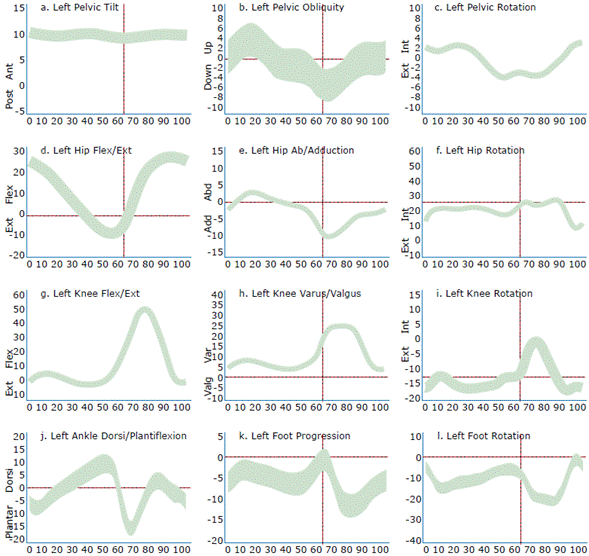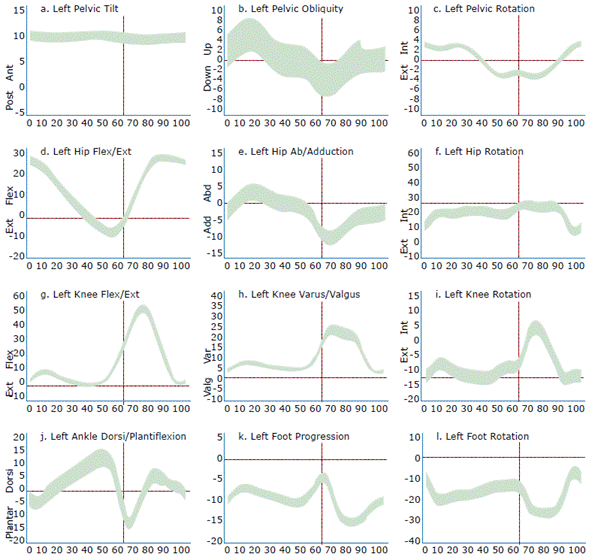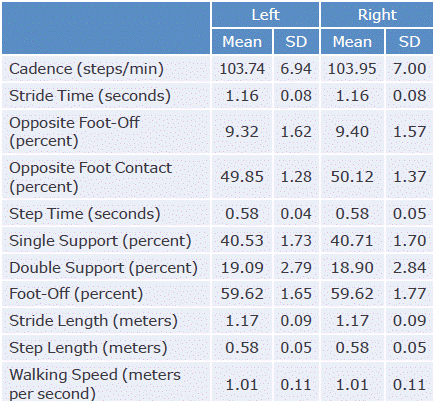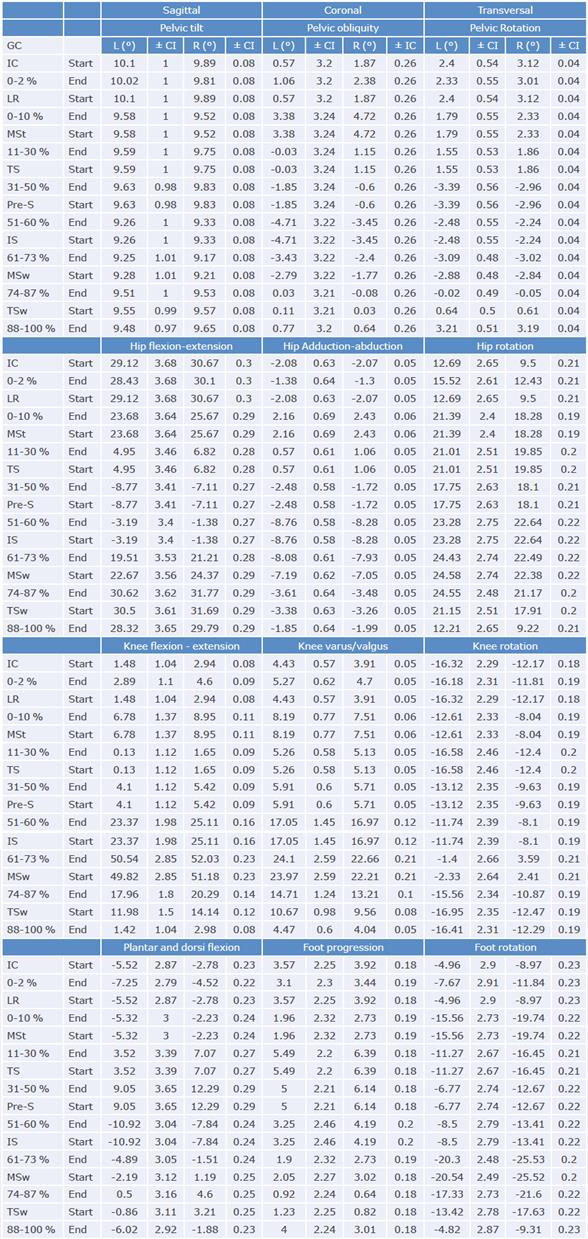Introduction
Gait is a rhythmic and cyclical activity that engages the entire body, especially the lower limbs, to generate the characteristic bipedal locomotion of humans.1 Exploring and analyzing gait in the context of the clinical and functional evaluation of human body locomotion constitutes a fundamental tool to uncover possibilities of movement, the capacity to fulfill different daily activities, and the level of social interaction of each individual. 1 For this reason, the aims of computerized gait analysis include establishing a differential diagnosis of related illnesses; assessing the severity, extension and nature of injuries; monitoring changes in the presence and absence of intervention or treatment; and predicting the outcomes of these interventions. 2
In this regard, there are observational methods1 available in clinical practice that have been used in combination with quantitative parameters to achieve accurate gait analyses. Nevertheless, since some intra- and inter-subject inconsistencies have been found in observational studies with respect to clinical gait assessment, it is necessary to resort to the expertise of the observers to avoid errors and biases that could lead to the inability to perform comparable follow-ups.
The quantitative data that is measured and used in therapeutic and diagnostic decision-making includes kinematic articulation in the three planes of motion (sagittal, frontal, and transverse), walking speed, swing period, support period and the subphases of the gait cycle. All these aspects allow accurately interpreting the outcomes.3-5
To provide a solution for the measurement issues mentioned above and to perform a more objective evaluation, high-quality systems such as gait analysis laboratories have been designed. These laboratories are considered as one of the most comprehensive and sophisticated evaluation methods since they provide an objective and quantitative assessment of the different parameters of human gait, 2 which are essential and necessary for the proper evaluation and diagnosis of gait alterations, and, also, for therapeutic follow-up and making clinical decisions (surgeries, orthoses, prosthesis).1 Previous studies have been performed in other countries to determine the parameters of normal gait in their populations; 6-10 however, studies reporting gait reference parameters in Colombian adults are yet to be conducted.
Consequently, a precise, accurate, and reliable qualitative and quantitative method of analysis is required to standardize gait parameters in a specific population group. Therefore, the objective of this cross-sectional study is to describes gait parameters in healthy Colombian young adults (aged 18 to 25 years), living in the department of Antioquia, Colombia.
Materials and methods
Study design and participants
This was a cross-sectional quantitative study. Participants were selected by non-probability convenience sampling. A total of 155 participants were recruited. Gait kinematics and temporal-spatial gait parameters were evaluated. Participants selected to join the study met the following inclusion criteria: being Colombian, male or female, aged 18 to 25 years, and willing to participate in the study and provide signed informed consent. Exclusion criteria included individuals with a history of neurological or musculoskeletal disease; patients with soft tissue injuries, surgeries affecting the center of gravity or core muscles; individuals requiring walking aids, orthosis and/or prosthesis; being pregnant; individuals showing any gait alteration; being overweight (body mass index (BMI) >24.9 kg/m2); being underweight (BMI<18 kg/m2); high-performance athletes; having undergone lower limb surgeries, and having pain during evaluation or in the week before the assessment.
Pre-capture measurements
Prior to gait capture, height and BMI were calculated. Data from each participant was collected by means of a survey administered by a member of the research team. Anthropometric measurements were made following Plug-in Gait full body modeling references in the VICON NEXUS 1.8.5 motion capture software, which includes 35 markers. 11
Capture
The system was previously calibrated and fed with the anthropometric measurements of each participant. Participants walked on a 6-meter straight track, at their own speed, and barefoot. At first, movement was not recorded so that participants could adapt to the laboratory environment and the markers. Subsequently, a 3D capture system with following characteristics was used: eight 1.0 megapixel infrared cameras (Bonita 10) with a speed of 250 frames per second. 12 The VICON NEXUS 1.8.5 software was used to assess gait kinematics. A minimum of 7 captures were taken, 3 strides per capture. The acquired data were processed using the POLYGON 4.1 software.13
Statistical analysis
Values from an algorithm implemented in the Octave software were used to obtain the normal values for gait kinematics (movement of the arc in the sagittal, coronal and transverse planes of the main joints of the lower limbs) and temporal-spatial gait parameters (cadence, stride time, opposite foot-off, opposite foot contact, step time, single support, double support, foot-off, stride and step length, and walking speed). The obtained data followed a normal distribution, so mean and standard deviation measures were calculated. With that in mind, the standard error was calculated with a 95% confidence interval (CI); the resulting value was added and subtracted from the mean to obtain the upper and lower limits of the CI for each of the variables. Subsequently, variables X and Y were plotted: X was defined as the percentage of the gait cycle, and Y as the kinematic variable of interest; in this way, it was possible to determine an area with the upper and lower interval limits of a 95%CI. Data were processed using the STATA v. 12.1 software.
Ethical considerations
This work was carried out in accordance with the Declaration of Helsinki14 and Resolution 8430 of 1993 of the Colombian Ministry of Health. 15 The Ethics Committee of Universidad CES approved and endorsed this study through Minutes 77 of February 16, 2015. All participants in this study were provided with and signed an informed consent.
Results
A total of 155 participants were included. The study population consisted of 41.29% (n=64) males, with an average age of 20.3 years, average height of 166 cm, and average BMI of 21.91. The following temporal-spatial gait parameters were measured in all participants: cadence, stride period, opposite foot-off, step time, single support, double support, foot-off, stride length, step length, and walking speed.
Table 1 shows the mean and standard deviation of each of the analyzed parameters. Figures 1 and 2 depict the peak joint angles in the different planes assessed during the gait cycle of both lower limbs, as well as the left and right lower limb kinematic parameters (95%CI), respectively.

Source: Own elaboration.
Figure 1 Left lower limb kinematics. The horizontal axis shows the percentage of gait cycle. Pelvic mobility: a) lateral plane (posterior and anterior pelvic obliquity), b) frontal plane, upper and lower pelvic obliquity; and c) transverse plane (external and internal pelvic rotation). Hip mobility: d) lateral plane (extension and flexion), e) frontal plane (abduction and adduction), f) transverse plane (external and internal hip rotation). Knee mobility: g) lateral plane (extension and flexion), h) frontal plane (valgus/varus), i) transverse plane (external and internal knee rotation). Ankle mobility: j) lateral plane (dorsiflex-Ion and plantar flexion), k) frontal plane (foot progression angle), I) transverse plane (external and internal ankle rotation).

Source: Own elaboration.
Figure 2 Right lower limb kinematics. The horizontal axis shows the percentage of gait cycle. Pelvic mobility: a) lateral plane (posterior and anterior pelvic obliquity), b) frontal plane, upper and lower pelvic obliquity, and c) transverse plane (external and internal pelvic rotation). Hip mobility: d) lateral plane (extension and flexion), e) frontal plane (abduction and adduction), f) transverse plane (external and internal hip rotation). Knee mobility: g) lateral plane (extension and flexion), h) frontal plane (valgus/varus), i) transverse plane (external and internal knee rotation). Ankle mobility: j) lateral plane (dorsiflex-Ion and plantar flexion), k) frontal plane (foot progression angle), I) transverse plane (external and internal ankle rotation).
Regarding gait kinematics, the following parameters were analyzed in the sagittal, coronal, and transversal planes: pelvictilt, obliquity, and rotation; hip flexion-extension, abduction/adduction, and rotation; knee flexion-extension, valgus/varus, and rotation; foot dorsi-flexion, progression, and rotation (Annex 1). The average values of the angles of each of the evaluated kinematic parameters are shown in Figures 1, 2 and Annex 1.
Discussion
Motion capture software was used in this study to describe gait parameters in healthy Colombian young adults. Compared to descriptive observational studies, gait assessment and analysis in motion labs provide more accurate data; for this reason, they have become the leading method to evaluate the movements of the human body. Furthermore, data obtained in said labs offer the necessary information for proper patient care, treatment decision-making, and diagnosis of alterations in gait. Also, it is a useful tool for the research and design of intervention strategies.16
By performing a cross-sectional study, this paper describes reference gait parameters in healthy Colombian adults aged 18 to 25 years old. In this regard, reference values for gait parameters are needed to identify deviations from the normal pattern.16,17 Previous studies have established reference temporal-spatial gait parameters in healthy populations and have even reported sex differences.17-21
According to Al-Obaidi etal., the average walking speed can be calculated and classified as slow (average speed of 0.82 m/s), medium (average speed of 1.191 m/s) orfast (average speed of 1.675 m/s); the average speed of the participants in the present study was of 1.00±0.1 m/s. Based on previous works, this speed could be classified as slow gait, and it is lower than that reported by other authors in similar populations, 5,17,22 with a walking speed between 1.2238 m/s and 1.38 m/s. The differences in these values are likely explained by differences in stride and height since the average step length in the present study was 0.58±0.05m, compared to 0.66m and 0.61m for Swedish men and 0.59m for Swedish women as reported by Al-Obaidi et al.5
Speed has been associated with variables such as step length, limbs length, height and cadence.3 In this study, the step length was 0.58m and the average height was 166 cm, which are similar to those reported in studies conducted in similar age groups, with step lengths between 0.59m and 0.70m and heights that oscillate between 164cm and 180cm. 5,17,22 To make the data comparable between populations of different heights, several standardizations that include height, step length or limb length are frequently used. 23,24 Thus, after normalizing the walking speed with respect to height, the present study found an average walking speed of 0.6 height/sec, which is lower than the values reported by Al-Obaidi et al.5 (0.66-0.70). It should be noted that the environment, the surroundings and the individual's mood can modify gait; 2,16,18 consequently, participants analyzed here were asked to walk as they usually do, and were given around 3 minutes to adapt to the markers and the lab setting.
Moreover, gait kinematics results obtained here are comparable to those reported by similar studies; however, asymmetries between sides in reference curves are rarely mentioned,4,25,26 in spite of their relevance since they are usually related to cerebrovascular disease, amputations, osteoarthritis, and ankle sprains in the clinical setting.27 Recent studies, such as the Global Gait Asymmetry (GGA) index, have attempted to identify the normalcy range of gait asymmetry,28 and even though this study was not intended to quantify asymmetries, or use such indexes, it allowed establishing gait kinematic reference parameters for the right and left side in the study population.
The kinematic findings of the present study are consistent with those reported in similar studies that illustrate joint movement during walking. 26,29,30 However, this study describes joint movement with ranges of normality that are narrower than those reported by said studies, 22,29,31 which implies lower amplitude graphs. For example, Fryzowicz et al.22 show an articular arc in the sagittal plane of the pelvis close to 6 degrees, while Bruening et al.32 report 4.5 degrees of anteversion in men, which is significantly lower than the 9.5 degrees reported in the present study, thus denoting greater pelvic anteversion in our study population.
The availability and use of these data may allow for a better physical therapy and orthopedic approach, as well as specific occupational interventions for the Colombian population. Moreover, it provides a starting point for further research of different pathologies and for establishing novel methods to treat and predict musculoskeletal alterations.33,34 Further gait analysis requires the inclusion of kinetic results that consider the forces generated in the joints.26,28,35
Conclusions
The findings reported here show the behavior of joint kinematics in a sample of Colombian young adults. This is the first study of its kind in Colombia conducted in a healthy population group, and it describes differences in kinematic and temporal-spatial variables when compared to data reported by similar studies conducted in populations of other countries. Findings differ in terms of normalcy ranges, which lead us to think that the ranges used to compare patients in Colombia are not adequate, making it necessary to conduct more studies to establish comparison parameters.
In conclusion, the data obtained here will allow establishing the characteristics of normal gait in Colombian young adults, improving intervention strategies, and leading to design and implement technical aids aimed at improving locomotion in Colombian individuals.
















